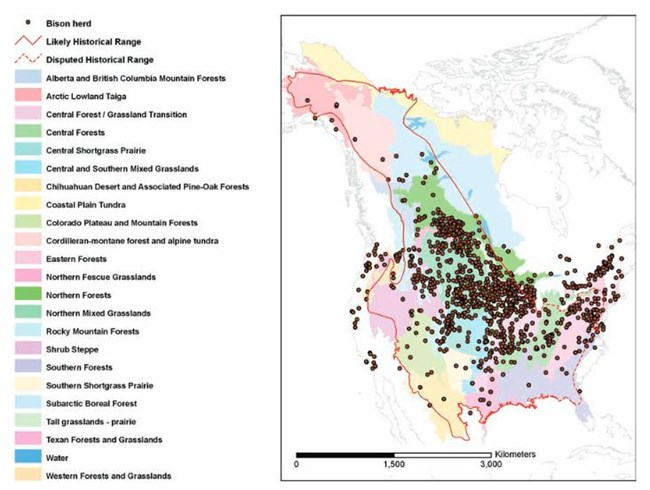Last updated: November 6, 2017
Article
Bison Bellows: Back Home on the Range

Photo courtesy of Sanderson, E.W., Redford, K.H., Weber, B., et al. (2008). The ecological future of the North American Bison: Conceiving long-term, large-scale conservation of wildlife. Conservation Biology 22: 252-266
The words people use to describe the geographic ranges of bison differ immensely depending on the historical time period they are referring to. Even so, when talking about the historical range and population of bison before European settlement, people undeniably use words such as vast, large numbers, and expansive. Historical journals often illustrate the immense range and herd sizes with phrases such as "the plains were black and appeared to be moving," "as numerous as the locus in Egypt," and "could not see their limit either east or west."
Historical records, although sometimes disputed, predict that the bison's original geographic range extended from the arctic lowland taiga forests of Alaska south to the western grasslands of Mexico and stretched from the Great Basin of Nevada to the eastern Appalachian Mountains. It is estimated that the original bison range was 9.4 million km2 and encompassed 22 major biomes. The largest North American mammal once inhabited almost two-thirds of the North American continent. There are only a few species today--- such as the American robin, common house mouse, and white-tailed deer--- that are found across the entire North American continent. However, due to land-use changes and human expansion, species the size of a bison do not have the ability to stretch as far and wide as the bison once did.
The bison's enormous range drastically changed as European settlers began moving west in the late 1800s. Between 1867 and 1883, the transcontinental railroad was built through the center of the bison range, splitting the population in half. By 1883, these two split populations were decimated so much by hunting, that only 1,000 individuals were left. It is estimated that so many bison were killed, that their bones could fill a 7,575-mile long train---from San Diego to Anchorage and back. Because of this great killing, only small, isolated populations of bison remained although their potential range remained large.
Had it not been for the interest of a few private citizens in raising bison in captivity and the small wild populations found in Yellowstone National Park and Alberta, Canada, bison would be extinct today. Currently, individual bison herd ranges are small and the species no longer occupies its historic range as wildlife. Indeed, most wild bison ranges today are small due to land-use changes that hinder the species capability to range freely as wildlife across the historic range in all three countries. Some wild bison can still be found in national parks, wildlife refuges, and on tribal lands, but most bison today exist as private property on private lands. However, through conservation efforts, bison are returning back home on their range. There are currently 17 federal bison herds that range west of the Mississippi River, with most of these herds found within their historical range.
